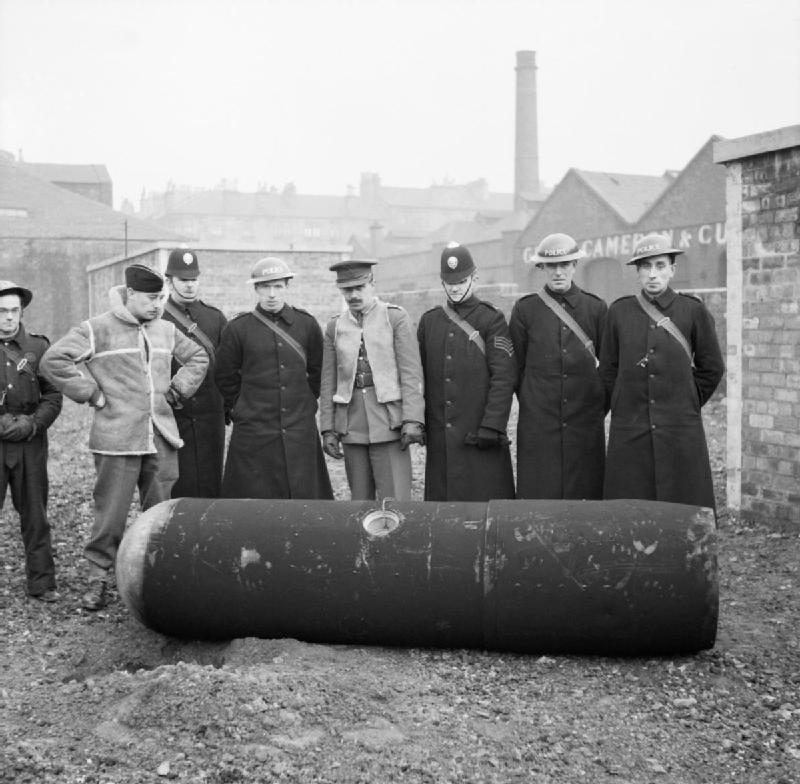Parachute Mine on:
[Wikipedia]
[Google]
[Amazon]
 A parachute mine is a naval mine dropped from an aircraft by
A parachute mine is a naval mine dropped from an aircraft by
Archived Version
of page wit
Aerial bombs Mine warfare Explosive weapons Naval mines
 A parachute mine is a naval mine dropped from an aircraft by
A parachute mine is a naval mine dropped from an aircraft by parachute
A parachute is a device used to slow the motion of an object through an atmosphere by creating drag or, in a ram-air parachute, aerodynamic lift. A major application is to support people, for recreation or as a safety device for aviators, who ...
. They were mostly used in the Second World War by the Luftwaffe and initially by the Royal Air Force (RAF) Bomber Command.
Frequently, they were dropped on land targets.
History
Luftwaffe
During the Second World War, the Luftwaffe used a number of different kinds of parachute mines. The ''Luftmine'' A (LMA) and ''Luftmine'' B (LMB) weighed and respectively. The LMA was in length and the LMB . After the parachute opened, the mine would descend at around . If it came down on land, a clockwork mechanism would detonate the mine 25 seconds after impact. If the mine landed in water it would sink to the bottom. If the depth was greater than , water pressure and the dissolving of a water–soluble plug would deactivate the clockwork time-detonator, and activate an anti-shipping detonator. These were initially magnetic detonators but later, acoustic or magnetic/acoustic detonators could be fitted. The Luftwaffe began dropping mines in British waters in November 1939, using Heinkel He 115 seaplanes andHeinkel He 111
The Heinkel He 111 is a German airliner and bomber designed by Siegfried and Walter Günter at Heinkel Flugzeugwerke in 1934. Through development, it was described as a "wolf in sheep's clothing". Due to restrictions placed on Germany after th ...
land–based bombers. The new British cruiser, HMS ''Belfast'', was damaged by a parachute mine on 21 November in the Firth of Forth
The Firth of Forth () is the estuary, or firth, of several Scottish rivers including the River Forth. It meets the North Sea with Fife on the north coast and Lothian on the south.
Name
''Firth'' is a cognate of ''fjord'', a Norse word meani ...
, while the destroyer HMS ''Gipsy'' was damaged at Harwich
Harwich is a town in Essex, England, and one of the Haven ports on the North Sea coast. It is in the Tendring district. Nearby places include Felixstowe to the north-east, Ipswich to the north-west, Colchester to the south-west and Clacton-on- ...
on the same night.
The threat to shipping posed by magnetic detonators was effectively negated after a German parachute mine was captured intact when it landed in mud in the Thames Estuary. Thereafter, a ship's magnetic field could be counteracted by a process called degaussing. This involved either the installation of electric wires around the inside of the hull, or for smaller vessels, by passing an electric cable under the hull, known as "wiping".
Parachute mines were first used against land targets on 16 September 1940 in the early stages of the Blitz. It was rumoured that Hermann Göring had ordered parachute mines to be dropped on London in a fit of temper, but it is more likely that they were originally intended to disrupt shipping in the London Docks. From October 1940, mines were also dropped in raids on other British cities such as Birmingham, Liverpool, Manchester and Coventry. Clearance of these was carried out by the Royal Navy, which quickly dispatched a team to London from HMS ''Vernon'', while Army bomb disposal staff were warned that it was extremely inadvisable to attempt to render them safe without Naval guidance. The official British designation for these weapons on land was "Parachute Landmines", but civilians just called them "land mines".
The singer Al Bowlly was killed by a parachute mine which exploded outside his flat in Jermyn Street, London during the Blitz on 17 April 1941.
In 1941 a parachute bomb destroyed Victoria Hall, Sunderland, Tyne and Wear, site of the Victoria Hall disaster of 1883.
The use of standard parachute mines declined after 1941, but the Luftwaffe later used the Bombenmine (BM 1000, Monika, or G Mine). This was fitted with a tail made from Bakelite
Polyoxybenzylmethylenglycolanhydride, better known as Bakelite ( ), is a thermosetting phenol formaldehyde resin, formed from a condensation reaction of phenol with formaldehyde. The first plastic made from synthetic components, it was developed ...
which broke up on impact. It had a photoelectric cell beneath a cover which detonated the bomb if exposed to light to counteract the work of bomb disposal units.
RAF
The RAF initially used naval mines, but replaced them with purpose-made blockbuster bombs, which were produced in various sizes up to .References
{{ReflistExternal links
Archived Version
of page wit
Aerial bombs Mine warfare Explosive weapons Naval mines